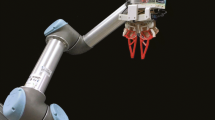Abstract
Autonomous grasping is an important but challenging task and has therefore been intensively addressed by the robotics community. One of the important issues is the ability of the grasping device to accommodate varying object shapes in order to form a stable, multi-point grasp. Particularly in the human environment, where robots are faced with a vast set of objects varying in shape and size, a versatile grasping device is highly desirable. Solutions to this problem have often involved discrete continuum structures that typically comprise of compliant sections interconnected with mechanically rigid parts. Such devices require a more complex control and planning of the grasping action than intrinsically compliant structures which passively adapt to complex shapes objects. In this paper, we present a low-cost, soft cable-driven gripper, featuring no stiff sections, which is able to adapt to a wide range of objects due to its entirely soft structure. Its versatility is demonstrated in several experiments. In addition, we also show how its compliance can be passively varied to ensure a compliant but also stable and safe grasp.














Similar content being viewed by others
References
Brown, E., Rodenberg, N., Amend, J., Mozeika, A., Steltz, E., Zakin, M. R., et al. (2010). Universal robotic gripper based on the jamming of granular material. Proceedings of the National Academy of Sciences, 107(44), 18809–18814.
Calisti, M., Arienti, A., Giannaccini, M. E., Follador, M., Giorelli, M., Cianchetti, M., Mazzolai, B., Laschi, C., & Dario P. Study and fabrication of bioinspired octopus arm mockups tested on a multipurpose platform. In 2010 3rd IEEE RAS and EMBS International Conference on Biomedical Robotics and Biomechatronics (BioRob) (pp. 461–466).
Cheng, N. G., Lobovsky, M. B., Keating, S. J., Setapen, A. M., Gero, K. I., Hosoi, A. E., & Iagnemma, K. D. (2012). Design and analysis of a robust, low-cost, highly articulated manipulator enabled by jamming of granular media. In 2012 IEEE International Conference on Robotics and Automation (ICRA) (pp. 4328–4333).
Deimel, R., & Brock, O. (2013). A compliant hand based on a novel pneumatic actuator. In 2013 IEEE International Conference on Robotics and Automation (ICRA) (pp. 2039–2045).
Dollar, A. M., & Howe, R. D. (2010). The highly adaptive SDM hand: Design and performance evaluation. The International Journal of Robotics Research, 29(5), 585–597.
Eppner, C., Bartels, G., & Brock, O. (2012). A compliance-centric view of grasping. Technical Report.
Feix, T., Pawlik, R., Schmiedmayer, H., Romero, J., & Kragic, D. (2009). A comprehensive grasp taxonomy. In Robotics, Science and Systems: Workshop on Understanding the Human Hand for Advancing Robotic Manipulation (pp. 2–3).
FESTO. Retireved February 26, 2013, from http://www.festo.com/rep/encorp/assets/pdf/BHAen.phf.
Giannaccini, M., Dogramadzi, S., & Pipe, T. (2011). Solutions for a variable compliance gripper design. In Towards Autonomous Robotic Systems. Lecture Note in Computer Science (Vol. 6856, pp. 410–411).
Giannaccini, M. E., Zheng, Y., Dogramadzi, S., & Pipe, T. (2012). Towards a variable compliance hydrostatic skeleton inspired gripper. In 2012 4th IEEE RAS and EMBS International Conference onBiomedical Robotics and Biomechatronics (BioRob) (pp. 246–251).
Grebenstein, M., Albu-Schaffer, A., Bahls, T., Chalon, M., Eiberger, O., Friedl, W., Gruber, R. et al. (2011). The dlr hand arm system. In 2011 IEEE International Conference on Robotics and Automation (ICRA) (pp. 3175–3182).
Hannan, M. W., & Walker, I. D. (2003). Kinematics and the implementation of an elephant’s trunk manipulator and other continuum style robots. Journal of Robotic Systems, 20(2), 45–63.
Hirose, S., & Umetani, Y. (1978). The development of soft gripper for the versatile robot hand. Mechanism and Machine Theory, 13(3), 351–359.
Ilievski, F., Mazzeo, A. D., Shepherd, R. F., Chen, X., & Whitesides, G. M. (2011). Soft robotics for chemists. Angewandte Chemie, 123(8), 1930–1935.
INTRO project. Retrieved February 27, 2013, from http://introbotics.eu/.
Kier, W. M. (2012). The diversity of hydrostatic skeletons. The Journal of Experimental Biology, 215(8), 1247–1257.
Kier, W. M., & Smith, K. K. (1985). Tongues, tentacles and trunks: The biomechanics of movement in muscular-hydrostats. Zoological Journal of the Linnean Society, 83(4), 307–324.
McMahan, W., Chitrakaran, V., Csencsits, M., Dawson, D., Walker, I. D., Jones, B., Pritts, A. M., Dienno, Grissom, D. M., & Rahn, C. D. (2006). Field trials and testing of the OctArm continuum manipulator. In Proceedings of 2006 IEEE International Conference on Robotics and Automation (ICRA 2006) (pp. 2336–2341).
Menciassi, A., Accoto, D., Gorini, S., & Dario, P. (2006). Development of a biomimetic miniature robotic crawler. Autonomous Robots, 21(2), 155–163.
Pfeifer, R., Lungarella, M., & Iida, F. (2007). Self-organization, embodiment, and biologically inspired robotics. Science, 318(5853), 1088–1093.
SCHUNK. Retrieved January 30, 2013, from http://www.gb.schunk.com/schunk/schunk_websites/products/products.html?product_level_1=244&product_level_2=250&product_level_3=0&&country=GBR&lngCode=EN&lngCode2=EN.
SHADOW. Retrieved February 26, 2013, from http://www.shadowrobot.com/hand/motorhand.shtml.
Taylor, J. R., & Kier, W. M. (2003). Switching skeletons: Hydrostatic support in molting crabs. Science, 301(5630), 209–210.
Trimmer, B. A., Takesian, A., Sweet, B., Rogers, C. B., Hake, D. C., & Rogers, D. J. (2006). Caterpillar locomotion: A new model for soft-bodied climbing and burrowing robots. In 7th International Symposium on Technology and the Mine Problem (Vol. 1, pp. 1–10). Monterey, CA: Mine Warfare Association.
Vaidyanathan, R., Chiel, H. J., & Quinn, R. D. (2000). A hydrostatic robot for marine applications. Robotics and Autonomous Systems, 30(1), 103–113.
Acknowledgments
We would like to thank Yue Zheng, Peng Huang and Dr Peter Walters for their excellent hardware support, help in conducting the experiments and fruitful discussions about the prototype. This work has been funded by the European Commission. It is part of the INTRO (INTeractive RObotics Research Network) project, in the Marie Curie Initial Training Networks (ITN) framework, Grant Agreement No.: 238486
Author information
Authors and Affiliations
Corresponding author
Electronic supplementary material
Below is the link to the electronic supplementary material.
Supplementary material 1 (avi 13309 KB)
Rights and permissions
About this article
Cite this article
Giannaccini, M.E., Georgilas, I., Horsfield, I. et al. A variable compliance, soft gripper. Auton Robot 36, 93–107 (2014). https://doi.org/10.1007/s10514-013-9374-8
Received:
Accepted:
Published:
Issue Date:
DOI: https://doi.org/10.1007/s10514-013-9374-8




